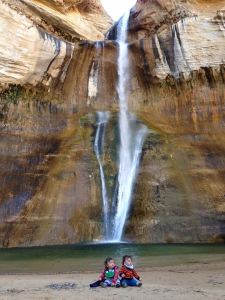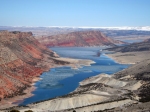It is not an adventure until something you would rather not happen happens. And you always want a good adventure. So it was good of two of our boat owners to oblige.
On a Thursday in mid June Kirsten and I drove from Torrey to the Sand Island campground in Bluff to meet up with a gang of pals from Durango. We arrived in the evening before the others and happily found plenty of camp sites available. Kirsten had her usual picnic feast ready and we sat at a table by the river noticing above all else a lot of water. Everything was damp and the river was swollen above its banks. We have had a wet May and June in the Southwest and the San Juan Mountains still had a lot of snow. Add the recent unseasonal rains and the river that in mid May had been running at 1800 cubic feet per second was now at 8,000 cfs. In fact we had experienced two separate pulses of moisture from tropical storms already by mid June, an unprecedented event for so early in the year. Global weirding.
Not wanting to take any chances I brought our camp stove and coffee pot for the first morning even though it was planned that a grab and go breakfast would be ready. The grab and go food was great but our coffee pot was mysteriously popular. I went with Ronni, our venerable boat captain, down to her camper to get her crew sized coffee pot but we seemed a tad slow in getting coffee going in it. We never did.
With the river high it was also fast. We only floated five miles the first day but stopped often to visit several terrific petroglyph panels including Butler Wash and another massive wall near our camp site. During the day the two adult sons, Sean and Casey, joked with their dad Mark about his paranoia about losing his boat. The next morning on the river Sean woke us up early saying we needed to get going. Their dad’s boat had disappeared during the night, “no joke.” Minus one.
We hustled to get going but still lined up eagerly for coffee at the well stocked camp kitchen. Tristen offered Kirsten some tea. Kirsten said no thanks, I’ll have coffee. Without missing a beat Tristen said, “The coffee went down the river. Would you like some tea?” Ah, missing a boat is no problem, kinda fun in fact, assuming we find it. But no coffee? Minus two.
.
Casey, a young man born for action and endurance was already headed downstream on a paddle-board by 6:30AM when we got up. We were on the river by nine and floated the remaining 22 miles to our planned takeout for the next day at Mexican Hat. It was a fast and beautiful trip. When we got to Mexican Hat Casey was there waiting for us. Besides one oar tangled in the flooded brush there had been no sign of the boat. We pulled all but one of the boats out while Mark and Casey took that boat on down the next 55 miles to the next and last takeout before the river runs a waterfall and meets its doom at Lake Powell.
Back in Torrey we learned they found the boat tied up another seven miles down the river. We had Ronni, who coincidentally has recently moved to Teasdale, over for dinner in Torrey. We only found out then from Ronni that the chief menu planner, who’s name I omit to protect the guilty, had forgotten to pack the coffee. Totally minus two. Adventure indeed. A regular bullet past the head. Was the lost boat a mere ruse to cover up? Be careful what you wish for. Good times. Thanks to all who made it happen.

















